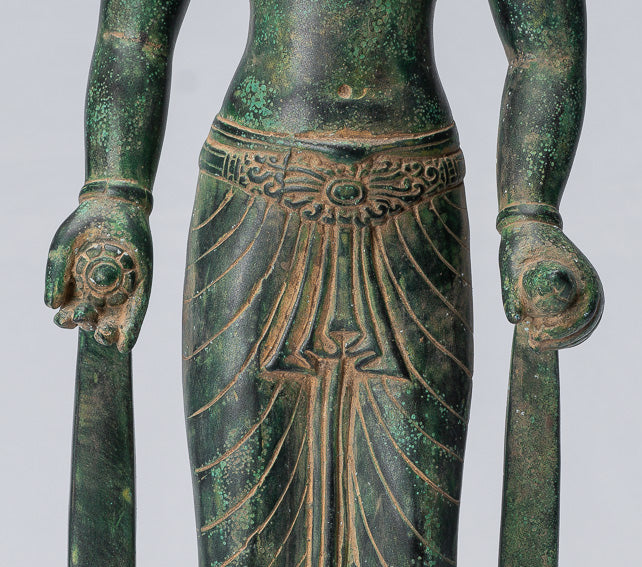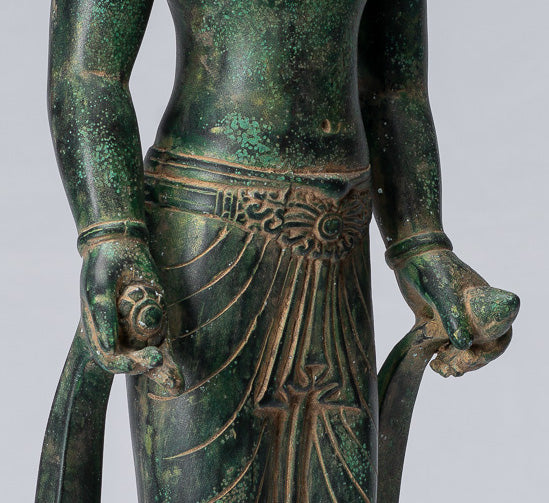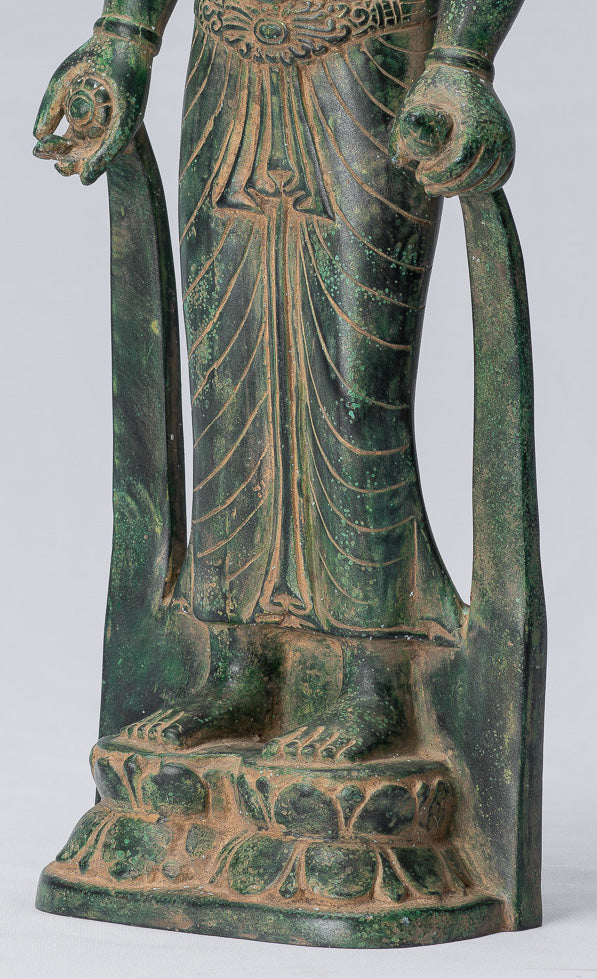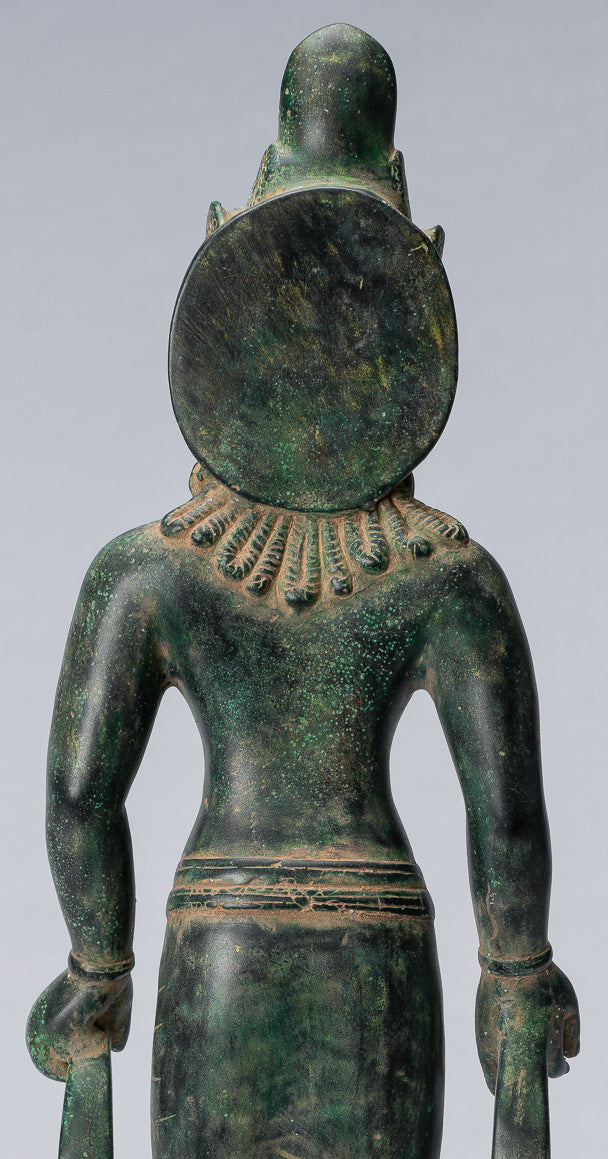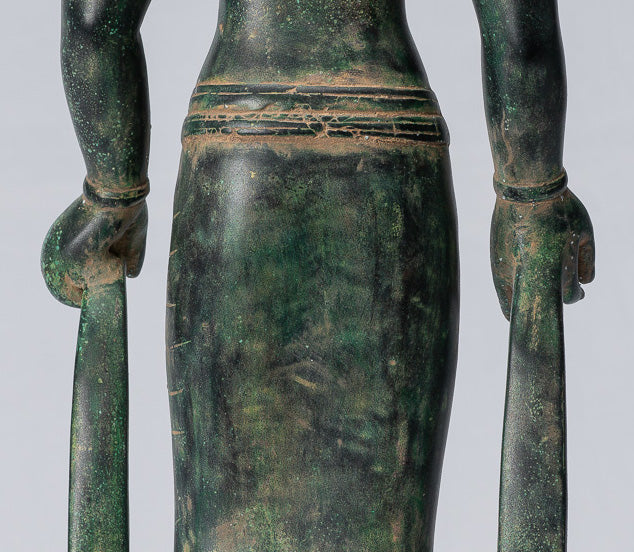-
Antique Phnom Da Style Bronze Guimet Museum Bodhisattva Avalokitesvara Compassion - 46cm/18"
Measures - (Height) 46cm/18"
An antique Phnom Da 9th century style Bodhisattva Avalokitesvara statue, the Bodhisattva of Compassion. Bodhisattva are beings who have gained enlightenment but postpone their ascension to nirvana to help others achieve the blessed state.
A similar sculpture to this piece can be found in the preeminent museum of Southeast Asian Art - Musee National des Arts Asiatiques - Guimet, Paris (MA5063).
In his classic work 'Lost Kingdoms' John Guy states of a similar piece 'arguably the most beautiful image of the Buddhist embodiment of compassion from all of Southeast Asia'.
The saviour Avalokitesvara stands on a pair of lotus blooms, his eyes downcasts as he extends grace to devotees. He wears a pleated waist cloth and an elaborate diadem with the Amitabha Buddha prominently displayed. His head is framed by an elliptical nimbus (mukhamandala) that extends upward to form the flaming shrine of the meditating Amitabha Buddha, seated atop a lotus throne on tiered locks of hair (jatamukuta). The nimbus is otherwise undecorated on the front but has a radiating pattern on the reverse, with two registers of ringlets of hair extending to the shoulders. Both hands are lowered, the left holding a lotus bud, evoking Padmapani, the lotus-bearer form of Avalokitesvara; the other holds what was likely intended to represent the round neck of an ascetic's water vessel (kamandula).
Stylistically, this masterpiece relates to the school of sculpture associated with the pre-Angkorian centre of Phnom Da, southern Cambodia.
Avalokiteshvara is stood in a slightly flexed position, cascading locks of hair, and patterning of the torque and belt. The waist cloth is secured by a detailed belt with jewels set amid vegetal patterns, a design repeated in the torque. Both are intended to evoke the gold jewellery of the period and share the vocabulary of the central Cambodian Prei Kmeng style of the second half of the seventh century. The end of the skirt has a sprayed and pleated fishtail design, visible below the belt. Gracefully, sweeping folds extend the full length of the robe, defining the contours of the body, a treatment developed most fully in the Phnom Da style.
In all, these characteristics place the sculpture in the late seventh- or early eighth century setting and suggest a cultural sharing with the workshops of the Phnom Da school.
The statue is cast in the round, rather than as a relief on a stela. From this, we can infer that Khmer sculptors would have desired their artwork to be viewed from all sides and thus placed in the centre of temples rather than against a wall. While this artwork was religious - priests supervised its execution - its realism is unmistakable.
SATISFACTION GUARANTEE - We have been offering SE Asian Art for many years and are proud of the reputation we have developed for fair and honest listings. However, if for any reason, whatsoever, you are unhappy with your purchase please just let us know and we will provide a full refund. We want you to be 100% happy with your purchase.
-
The majority of orders will be shipped with DHL. This is a secure, express and fully tracked service.
Items less than 2Kg we typically ship using Royal Mail.
Once we receive your order we try to ship all orders the same or next working day.
Large and/or fragile pieces requiring palletising, specialist crating and/or extra packaging may take a little longer. Palletised shipments will be delivered curbside.
All orders over 35 GBP will be shipped free of charge.

-
We genuinely hope that all purchases delight.
However, if they do not, regardless of reason, we will refund all orders upon receipt of the unwanted item. Just notify us within 14 days of receiving your order that you wish to make a return and send the piece back to us with 30 days of delivery.
By clarifying your purpose, understanding pose and symbolism, carefully selecting material and size, and taking advantage of detailed product information, you can choose a Ganesha statue that genuinely supports your spiritual path and enhances your space.




